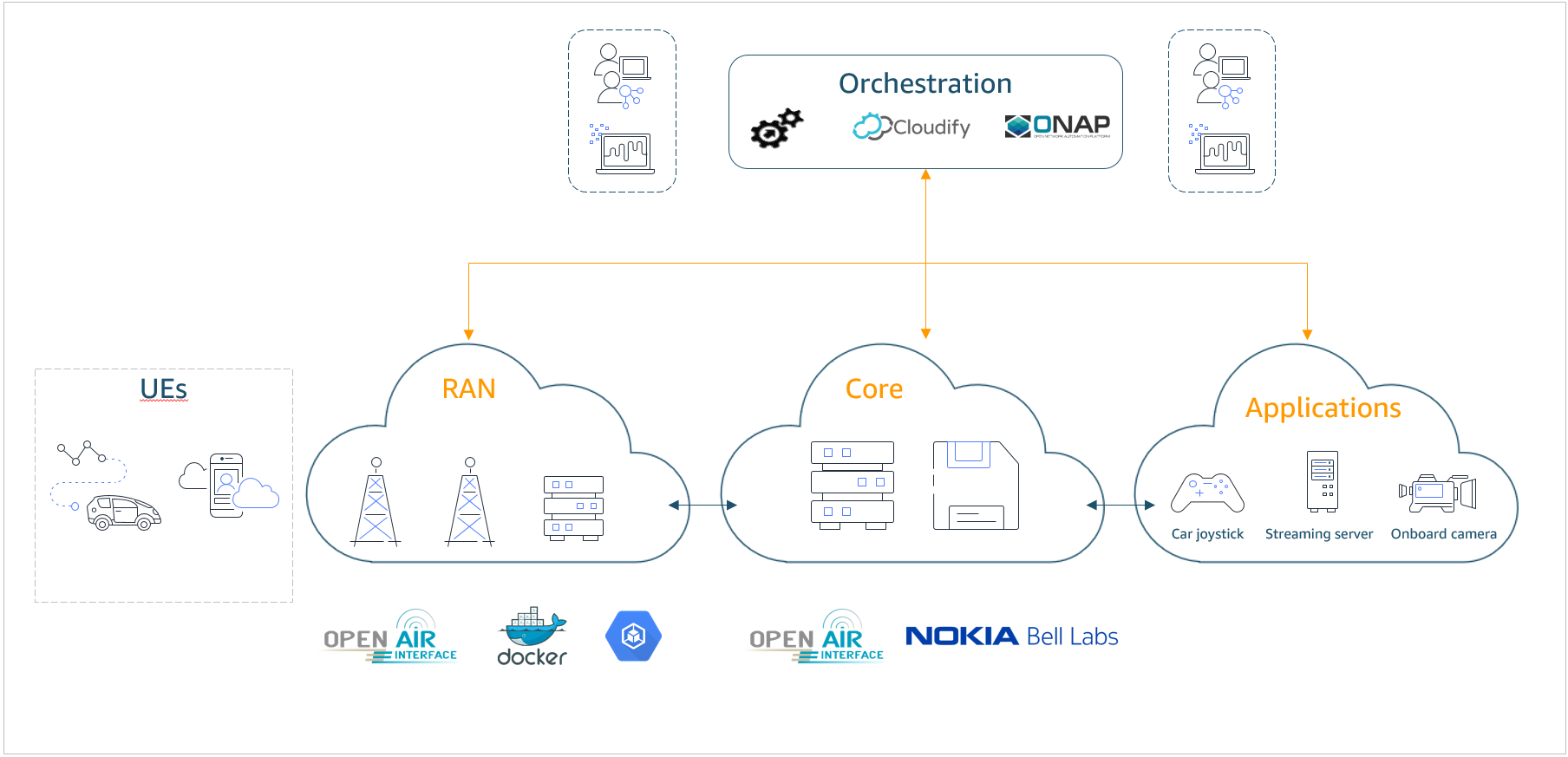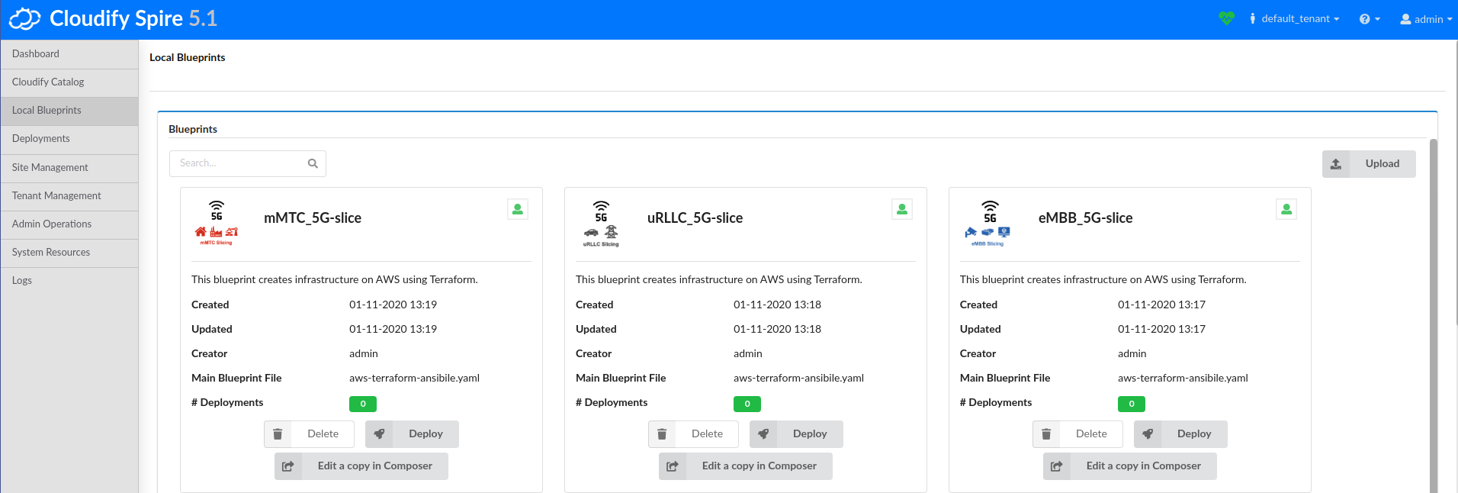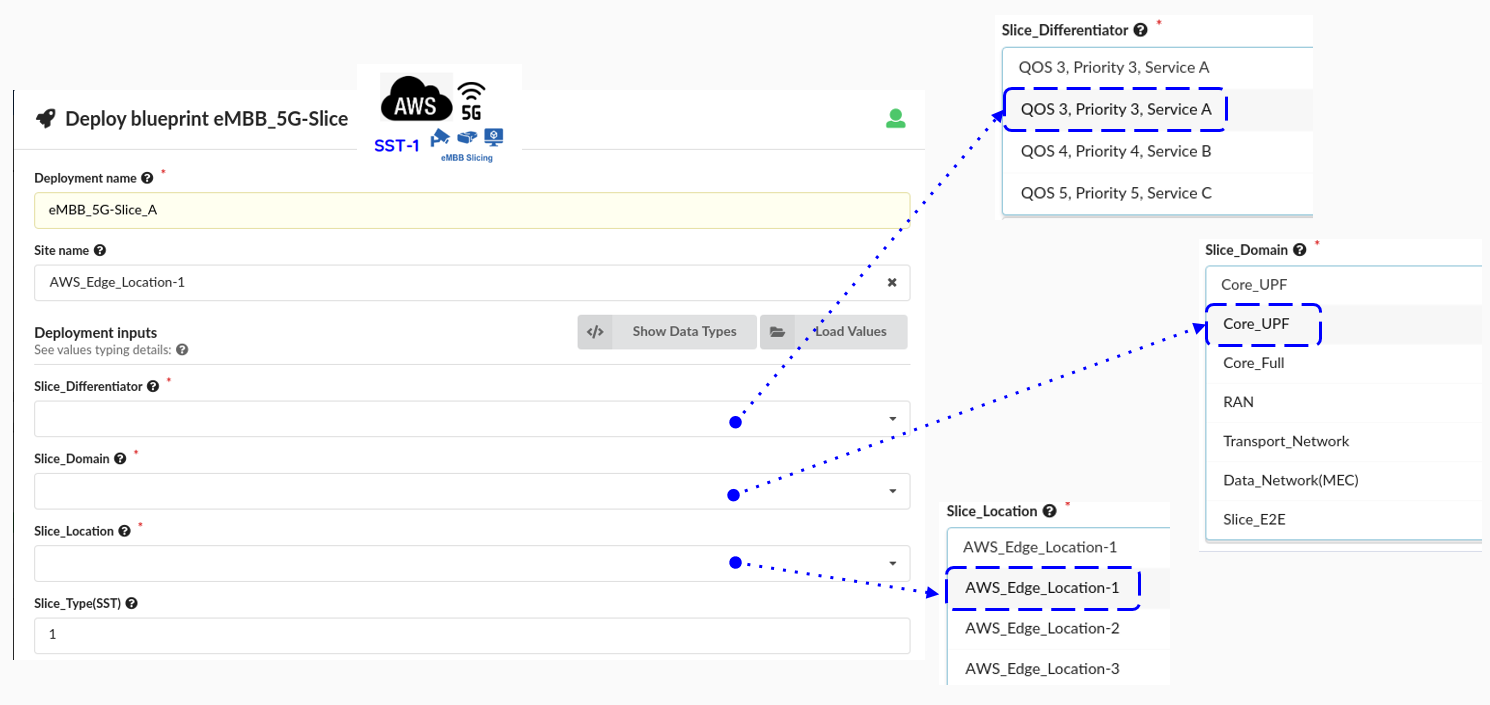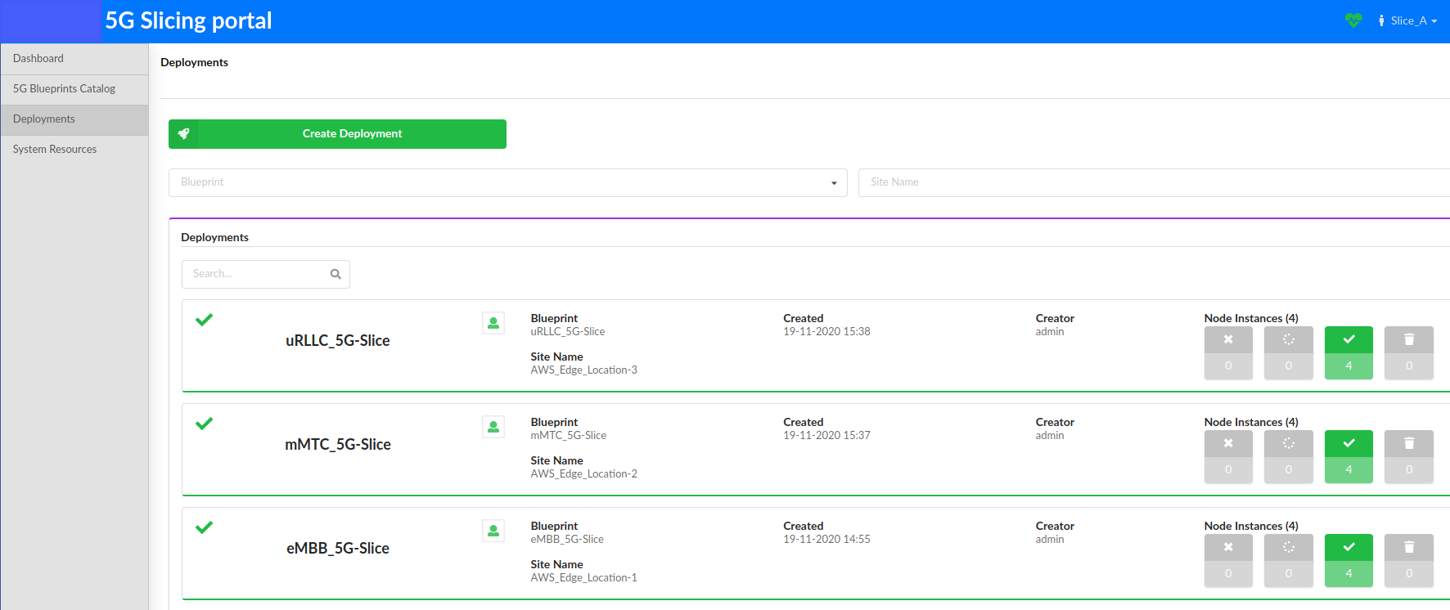AWS for Industries
Implementing 5G Network Slicing with Cloudify on AWS
Table of Contents
Cloudify Solution
Cloudify on AWS for Network Slicing
Conclusion
—
Recent advances in 4G and 5G cellular technologies have led to the adoption of virtualization of network functions, also known as Network Function Virtualization (NFV). Moving away from monolithic and vendor-specific equipment to a separation between hardware and software, 4G and 5G network functions can be hosted on general-purpose hardware (on-premises or in the cloud). Additionally, cloud-native principles of microservices-based architectures where network service elements can scale out independently based on demand is becoming the new paradigm. This trend has opened up the telco partner ecosystem to new players from ISVs, System Integrators (SI), and third-party managed services providers.
Management and orchestration (MANO) is telco industry-defined terminology and a key element of the ETSI Network Functions Virtualization (NFV) architecture. It is responsible for allocating and managing network resources for the lifecycle management of virtual network functions (VNFs), Cloud Native Network Functions (CNFs), and End-to-End Network Services (NS). MANO consists of NFV Orchestrator (NFVO), VNF Manager (VNFM), and Virtual Infrastructure Manager (VIM). The need for MANO solutions has risen with the evolution of 5G due to its service-based architecture, cloud-native components, and the scalability requirements that come with it.
In order for MANO solutions to deliver on its expected business outcomes for 5G, they need to oversee the entire operator’s network: Radio Access Network (RAN), Edge, Core, Data Network, and Centralized Cloud. This makes the AWS Cloud a perfect solution for 5G MANO due to AWS having a wide range of integrated services that are targeting different parts of an operator’s network such as:
- AWS Snow Family for RAN and Edge deployment
- AWS Outposts for Edge in addition to Core deployments
- AWS Wavelength for Data Network and IT Data Centers
- AWS Managed Services in AWS Regions to provide a single pane of glass for monitoring, management, and automation
One of the prime use cases of 5G that requires a great level of management and orchestration is 5G network slicing. 5G network slicing enables the operator to deploy multiple independent virtual E2E networks over the same infrastructure. Each slice can be customized for different services and/or business cases and can form a collection of 5G network functions for each specific use case and/or business model, supporting different requirements from all vertical industries. 5G slicing can span across all domains of the network: 5G device (UE), Access/RAN, Transport network/SDN, Core, and Data network, which could be Multi-access Edge Computing (MEC).
A key slicing concept is to be an isolated and self-contained entity that has all the functions and capabilities chained together to best meet all needs, services, and use cases.
Network Slice Instance (NSI) realized the network slicing concept by comprising a group of network functions, resources, and connection relationships and typically covers multiple 5G use cases. Three fundamental network slice types have been identified for 5G: enhanced Mobile Broadband (eMBB), massive Machine Type Communications (mMTC), and Ultra-Reliable Low Latency Communications (URLLC).
Examples of use cases that can take advantage of Network Slicing are:
- Virtual experience and media use cases, such as 4/8K real-time delivery, smart home/office/city, AR/VR and broadcast services
- Massive connectivity use cases, such as smart metering for gas and electricity, smart environment, smart farms and fishery, smart grid and sensor networks, personal and wearable devices
- Mission-critical use cases, such as autonomous driving, robotic applications, remote controlled machines, Industry 4.0, tactile internet, public safety networks, eHealth and remote surgeries
In this post, we describe in detail how Cloudify’s management and orchestration solution runs on AWS to create and manage the lifecycle of 5G network slices.
The Cloudify Solution
Cloudify is an open-source, multi-cloud, and edge orchestration platform that allows organizations an effortless transition to the AWS Cloud and to cloud-native architecture by enabling them to automate their existing infrastructure alongside cloud native and distributed edge resources.
Cloudify is used by many tier-1 carriers as a way to manage their network services and cloud infrastructure. Cloudify is also being used by VNF vendors as a VNF Manager (VNFM), to manage their specific network domains.
Cloudify’s flexibility to work with both existing on-premises infrastructure, managed network services such as SD-WAN, EPC, IMS, in addition to modern cloud-native services has been key to its ability to deliver successful NFV transformation projects to production. Cloudify is used by leading open-source community projects such as ONAP to demonstrate a fully open 5G network slicing as shown in the following Figure 1.
 Figure 1: Use of Cloudify with ONAP to deliver full 5G network slicing.
Figure 1: Use of Cloudify with ONAP to deliver full 5G network slicing.
Cloudify comes with native support for many AWS services including Amazon EKS, Amazon RDS, AWS Lambda, AWS CodePipeline in addition to AWS CloudFormation. The combination of native integration with AWS resources, in addition to support for AWS CloudFormation allows Cloudify to work with many AWS services without depending on specific resource mapping and integration as shown in the following Figure 2.
 Figure 2: Cloudify architecture on AWS.
Figure 2: Cloudify architecture on AWS.
Cloudify and AWS for Network Slicing
In order for a MANO solution to deliver 5G network slicing capabilities, it has to be able to create multiple network slices and manage lifecycles. This includes: slice template creation (design phase), slice instantiation (deployment phase), slice scaling, configuration management, and termination (operation phase).
AWS CodePipeline is used to fully manage the creation, deletion, management, and configuration of 5G core instances on Edge sites (AWS Outposts). Cloudify integrates to AWS CodePipeline via a set of plugins using an AWS Lambda set that acts as the northbound interface of AWS CodePipeline toward the Cloudify system. This enables the setup and configuration of the network slice from the operator view to the underlying core network as illustrated in the following Figure 3.
Each Lambda function is mapped to a specific AWS CodePipeline service and each AWS CodePipeline service is mapped to the lifecycle operation (create/delete/modify/verification) of a network slice.
A 5G mobile core slice domain (user plane function (UPF)) is created by instantiating a CNF on different Amazon EKS edge sites (Running on AWS Outposts). A process that is repeated for each network slice.
 Figure 3: Cloudify on AWS for network slicing.
Figure 3: Cloudify on AWS for network slicing.
One of the key concepts behind this layered architecture demonstrated previously is to abstract the detailed orchestration workflow and all the network configuration associated with it from the operator. In this context, the Cloudify catalog service is used to allow a simple interface to run network slicing as illustrated in the following screenshot.
 Figure 4: Providing a simple operator interface using Cloudify catalog service.
Figure 4: Providing a simple operator interface using Cloudify catalog service.
As part of slice creation, the user needs to fill several inputs which traverse into values on the fulfillment phase such as slice edge location, slice differentiator, slice domain (Core_UPF, Core_Full, RAN, MEC, Transport, Slice E2E). Slice execution includes Amazon EKS cluster deployment, UPF instantiation/licence activation/baseline config/day two config.
 Figure 5: Configuring a network slice.
Figure 5: Configuring a network slice.
Slice modification is implemented on an existing slice, which includes Core UPF within an existing Amazon EKS cluster. The user deploys an additional pipeline using Cloudify UI within the slice, and slice parameters are updated as part of the workflow. For this purpose, we have utilized SD (Slice Differentiator) values which represents a flavor of the existing slice. Updating slice flavor using day two config (SD) will affect QOS/Priority/services within the slice. Two options were evaluated: direct slice modification within UPF day2 config and centralized modification via PCF.
When deleting a network slice as part of lifecycle management, the user could remove all slice resources (Amazon EKS cluster, UPF…) utilizing the uninstall workflow.
The Cloudify Manager uses consistent workflows, with each slice execution task followed by a graphical view based on a Cloudify fulfillment execution graph and detailed logs. Each step of the creation process is followed by a verification task against the real state of the resources. After the orchestration, the user has full visibility using Cloudify UI for all slice resource states (runtime properties). The following Figure 6 shows the management portal.
 Figure 6: Manage network slices.
Figure 6: Manage network slices.
Conclusion
5G network slicing is becoming a critical feature supported by 5G in order to allow communication service providers to support a wide range of applications with different Service Level Requirements on the same network while keeping them isolated and secure.
Cloudify’s management and orchestration solution with its full integration to AWS services such as AWS CloudFormation, AWS CodePipeline, Amazon CloudWatch, Amazon EKS – alongside its support to provision workloads and clusters on-premises such as AWS Outposts, or on Amazon EKS anywhere – make it a great solution to support 5G network slicing use cases.
—
Co-Authored by
 Moshe Mizrachi is the Director of Solution Architecture at Cloudify. Moshe has over 25 years of experience in both Telco & Enterprise industry having filled a large variety of roles from Product Management, Presales, Network & Security architect , 5G/NFV/SDN Architecture and more. Moshe is well versed in both public and private cloud architecture, the container ecosystem, DevOps & automation platforms, VNFs, and mobile edge compute. Today he works with Service Providers and Enterprises to enable them to unleash the value of automation through orchestration, and driving multiple use cases from 5G and Edge to multi cloud orchestration enabled by Cloudify.
Moshe Mizrachi is the Director of Solution Architecture at Cloudify. Moshe has over 25 years of experience in both Telco & Enterprise industry having filled a large variety of roles from Product Management, Presales, Network & Security architect , 5G/NFV/SDN Architecture and more. Moshe is well versed in both public and private cloud architecture, the container ecosystem, DevOps & automation platforms, VNFs, and mobile edge compute. Today he works with Service Providers and Enterprises to enable them to unleash the value of automation through orchestration, and driving multiple use cases from 5G and Edge to multi cloud orchestration enabled by Cloudify.
 Hisham Elshaer
Hisham Elshaer
AWS Senior Consultant
 Vara Prasad Talari
Vara Prasad Talari
AWS Principal Consultant

Pragtideep Singh
AWS Consultant

Subbarao Duggisetty
Cloud Infra Architect

Franco Bontorin
Senior DevOps Consultant